
William H. Cabell was a Virginia lawyer, politician, plantation owner, and judge aligned with the Democratic-Republican party. He served as a Member of the Virginia House of Delegates, as Governor of Virginia, and as a judge on what later became the Virginia Supreme Court. Cabell adopted his middle initial in 1795—which did not stand for a name—to distinguish himself from other William Cabells, including his uncle, William Cabell Sr.

This is a list of the National Register of Historic Places listings in Cabell County, West Virginia.
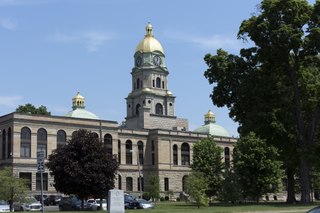
The Cabell County Courthouse in Huntington, West Virginia was built in the Beaux-Arts Classical style in 1899. Originally designed by Gunn and Curtis of Kansas City, and has been expanded in several phases. The construction of the courthouse was supervised by local Huntington architect James B. Stewart.
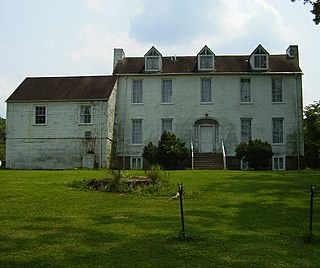
The Gen. Albert Gallatin Jenkins House — known historically as "Green Bottom" — is located on the east bank of the Ohio River about 7 miles north of Lesage, Cabell County, West Virginia.
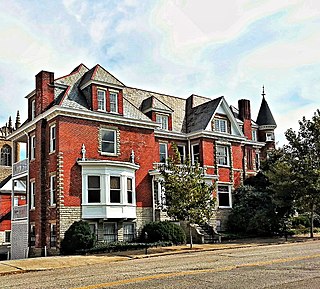
Campbell–Hicks House is a historic home located at Huntington, Cabell County, West Virginia. It was built in 1896, and is a 2+1⁄2-story, masonry dwelling in the Queen Anne style. It features a slender, two story cantilevered rounded tower. It also has a full front porch with a roof upheld by five sets of paired fluted columns with Ionic order capitals.

The Thomas Carroll House, also known as the Madie Carroll House, is an historic home located in the Guyandotte neighborhood in the city of Huntington, Cabell County, West Virginia. It is also known as one of the oldest structures in Cabell County. The original section of the house was built prior to 1810, and is believed to have arrived in Guyandotte by flatboat from Gallipolis, Ohio. The property was purchased by Thomas Carroll in March 1855 and remained under the ownership of his descendants until it was deeded to the Greater Huntington Parks and Recreation District on October 10, 1984, after the last tenant, Miss Madie Carroll's demise. It is one of the few houses in Guyandotte to survive the Civil War and even once was a church, an inn, and a home to many. During the Civil War the house was a safe haven for Union soldiers which is a rich history that the Madie Carroll House Preservation Society has spent the last few decades protecting and educating many on. As of today the house is owned and operated by the Madie Carroll House Preservation Society where they hold several events such as their annual Guyandotte Civil War Days. It is open to the public as a museum. It was listed on the National Register of Historic Places in 1973.
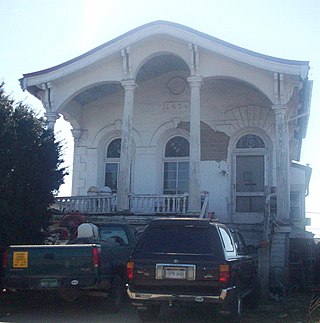
Harvey House, also known as the "Coin" Harvey House, is a historic home located at Huntington, Cabell County, West Virginia. It was built in 1874, and is a two-story dwelling reminiscent of houses in New Orleans. It features stained glass windows, a cast iron mantel, and a beamed ceiling in the dining room. It is most notable as the home of William Hope "Coin" Harvey.

Johnston-Meek House is a historic home located at Huntington, Cabell County, West Virginia. It is a two-story, brick Colonial Revival style dwelling with a hipped roof. The original section was built in 1832, with additions in 1838, 1923, and 1941. The 1923 Colonial Revival entrance portico and a number of other significant modifications were designed by local architect Sidney L. Day.
Kenwood, also known as the John A. Sheppard House, is a historic home located at Huntington, Cabell County, West Virginia. It was designed by the prominent West Virginia architect, H. Rus Warne, and built about 1910, and is a 2+1⁄2-story, rectangular, side gable house with flanking one-story, enclosed wings with flat roofs covered in green clay tile. The house measures approximately 100 feet long and 64 feet deep. It features an entrance portico with two story Tuscan order columns. The house is in the Classical Revival style with Greek Revival details. Also on the property is a contributing garage.
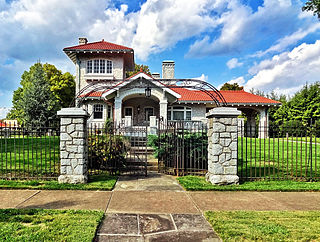
Prichard House is a historic home located at Huntington, Cabell County, West Virginia. It was built between 1921 and 1923, and is an Italian Renaissance-style residence. The house is built of gray North Carolina granite, topped by a Spanish tile roof, and sits on a reinforced concrete foundation. It features a distinctive two story tower and two roof garden chimneys. At the entrance to the property is the original wrought iron fence supported by granite pillars and iron gates. Also on the property are complementary and contributing guesthouse / garage and chicken house.
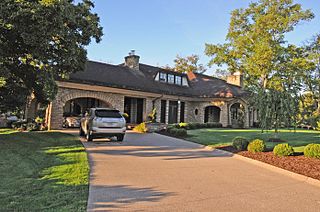
Ricketts House, also known as the Stevens Residence, is a historic home located at Huntington, Cabell County, West Virginia. It was designed in 1924, and built in 1925. It is a large stone dwelling with a complex, low pitched hipped roof punctuated by four large stone chimneys and with large overhanging eaves. The design is reflective of the Prairie School, with Tudor manor house influences. It is a significant and well-preserved work of the prominent Huntington architect, Levi J. Dean.

Zachary Taylor Wellington House is a historic home located at Huntington, Cabell County, West Virginia. It is a two-story I house form dwelling. It was originally constructed about 1847, as a small, 1+1⁄2-story, hall-and parlor house. About 1870, an addition and substantial changes were made giving the house its current appearance with Folk Victorian detailing. The house is associated with Zachary Taylor Wellington a prominent Republican politician who served in numerous public offices while residing in Guyandotte.

The Memorial Arch is a historic memorial arch located in Memorial Park at Huntington, Cabell County, West Virginia. It was built between 1924 and 1929 by the Cabell County War Memorial Association as a memorial to the dead and to those who served the county in World War I. It is built of gray Indiana limestone on a gray granite base. It measures 42 feet high, 34 feet wide, and 9 feet deep. It features Classical Revival style bas-relief carvings. The structure was rededicated in 1980. It is the only triumphal style arch in West Virginia.

The West Virginia Colored Children's Home was a historic school, orphanage, and sanatorium building located near Huntington, Cabell County, West Virginia. It was the state's first social institution exclusively serving the needs of African American residents. The main structure, built in 1922–1923, was a three-story red brick building in the Classical Revival style. That building, located at 3353 U.S. Route 60, Huntington, West Virginia, was the last of a series of buildings that were constructed on the site. It was also known as the West Virginia Colored Orphans Home, Colored Orphan Home and Industrial School, the West Virginia Home for Aged and Infirm Colored Men and Women, and University Heights Apartments. It was listed on the National Register of Historic Places in 1997 but was demolished in 2011.

Rotary Park Bridge is a historic arch bridge located in Rotary Park at Huntington, Cabell County, West Virginia, United States. Constructed between 1929 and 1930, the bridge is made of native rock-faced, square-cut ashlar in a rustic style. It measures approximately 175 feet long and 30 feet wide.

Mud River Covered Bridge is a historic covered bridge that formerly spanned the Mud River at Milton, Cabell County, West Virginia. It was built about 1875, and is a single-span, modified Howe truss structure. It measures approximately 112 feet (34 m) in length and 14 feet (4.3 m) in width.
Freeman Estate, also known as Park Hill Farm, is a historic home located at Freeman Estates, Huntington, Cabell County, West Virginia. The estate house was built between 1912 and 1914 and is a 2+1⁄2-story, masonry American Craftsman-style dwelling. It measures 11,000-square-foot (1,000 m2) and has a red, clay-tile roof.

Downtown Huntington Historic District is a national historic district located at Huntington, Cabell County, West Virginia. The original district encompassed 59 contributing buildings; the boundary increase added 53 more contributing buildings. It includes the central business district of Huntington and includes several of its municipal and governmental buildings. It contains the majority of the historic concentration of downtown commercial buildings. Located in the district are the separately listed Carnegie Public Library, Cabell County Courthouse, U.S. Post Office and Court House, and Campbell-Hicks House.
Hawthorne Historic District is a national historic district located at Huntington, Cabell County, West Virginia. The district encompasses 24 contributing buildings and 1 contributing structure in the Park Hills Subdivision No. 1. The district is composed entirely of early 20th century residences, the majority of which are Colonial Revival style.
Morris Memorial Hospital for Crippled Children, also known as Morris Memorial Nursing Home, is a historic hospital building located at Milton, Cabell County, West Virginia. It was built in 1936 by the Works Progress Administration as a hospital for children with polio. The modified U-shaped limestone building consists of a two-story central section, flanked by 1+1⁄2-story, Y-shaped wings. The central section features a domed and louvered cupola and a two-story portico. It has a T-shaped wing used as a school and a boiler house attached to the school wing by a hyphen. The hospital closed in 1960. It was subsequently used as a nursing home until 2009.



















